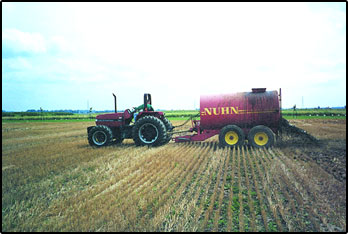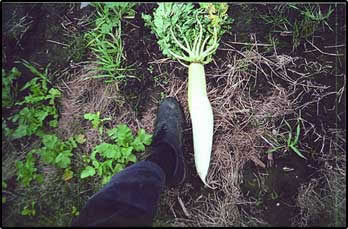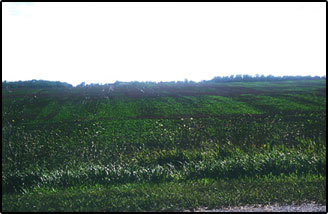
Crop Production
COVER CROP POTENTIAL
By Greg Stewart, OMAFRA Corn Specialist
 Applying manure to actively growing cover crops or establishing cover crops after manure incorporation may help reduce nitrogen losses. |
Fall Nitrogen Capture
An efficient cover crop, within the context of nutrient management, is one
which will: 1) tie up or sequester available nitrogen in the fall, 2) secure
this nitrogen from leaching over the course of the fall/winter/spring when
crop demand is low, and 3) release it to the corn crop in time for its phase
of rapid growth. This target of available nitrogen in the fall may be a result
of leftover nitrogen that the crop did not use or come from late summer or
fall applications of manure. The ability of a cover crop to capture this nitrogen
in the fall hinges mostly on its ability to grow rapidly after the main crop
has been harvested. This has been the traditional advantage held by an underseeded
cover crop like red clover compared to those cover crops that need to be seeded
in August. To assess the ability of various cover crops to sequester nitrogen
following winter wheat, trials were conducted in the early 1990s by University
of Guelph researchers T. Vyn, J. Faber, K.Janovicek and E. Beauchamp. Their
findings, outlined in Table 1, indicate that all four of the cover crops examined
(red clover was spring underseeded while fall rye, oilseed radish, and oats
were drilled following wheat harvest) were able to draw down soil nitrate
levels compared to the plots that had no cover crop. Interestingly, even red
clover, with its ability to fix nitrogen from the air, was as effective as
the other cover crops in reducing soil nitrate concentrations by the end of
the growing season.
| Table 1 Influence of cover crops on soil nitrate concentrations in the surface 60 cm (24 inches) when sampled in early November of the establishment year. Average of four sampling trials: Ayr, 1992 and 1993; Kirkton, 1992 and 1994. (Vyn et al., Agronomy Journal 92: #915-924) | |
|
Cover crop |
Soil Nitrate (PPM) |
|
Red Clover |
2.5 |
|
Fall Rye |
2.7 |
|
Oilseed radish |
2.8 |
|
Oats |
2.7 |
|
No Cover |
4.4 |
Other research has found that actively growing red clover will serve as a sink for manure nitrogen that is surface-applied. Nitrogen credits have been found to multiply in these systems; that is, the nitrogen credit for the manure applied to the cover crop is higher than the combined credits of the red clover and manure when acting separately. One of the ongoing difficulties with the use of red clover as a cover crop is the variability in the stand across the field. One approach to dealing with this is to direct-drill other cover crops (i.e., oilseed radish, peas, oats, etc.) after wheat harvest into just those areas of the field where the red clover stand is poor.
| Table 2 The influence of cover crops on soil nitrate concentrations taken in the pre-sidedress time frame (PSNT) and on corn yield when no fertilizer nitrogen was applied. Average Kirkton, 1993 and 1995. (Vyn et al. Agronomy Journal 92: #915-924) | ||
|
Previous Year |
Pre Sidedress |
Corn Yield (bu/ac) |
|
Red Clover |
22.4 |
144 |
|
Fall Rye |
14.5 |
108 |
|
Oilseed Radish |
17.1 |
114 |
|
Oats |
13.8 |
110 |
|
No Cover |
14.2 |
111 |
Establishing a vigorous cover crop where manure is to be applied of course implies that the manure (and cover crop) will n
 Fall-seeded oilseed radish can grow vigorously given good conditions prior to season-ending frosts. |
 Uneven stands continue to plague red clover as a cover crop. Filling in poor areas by drilling other cover crops after wheat harvest is an option. |